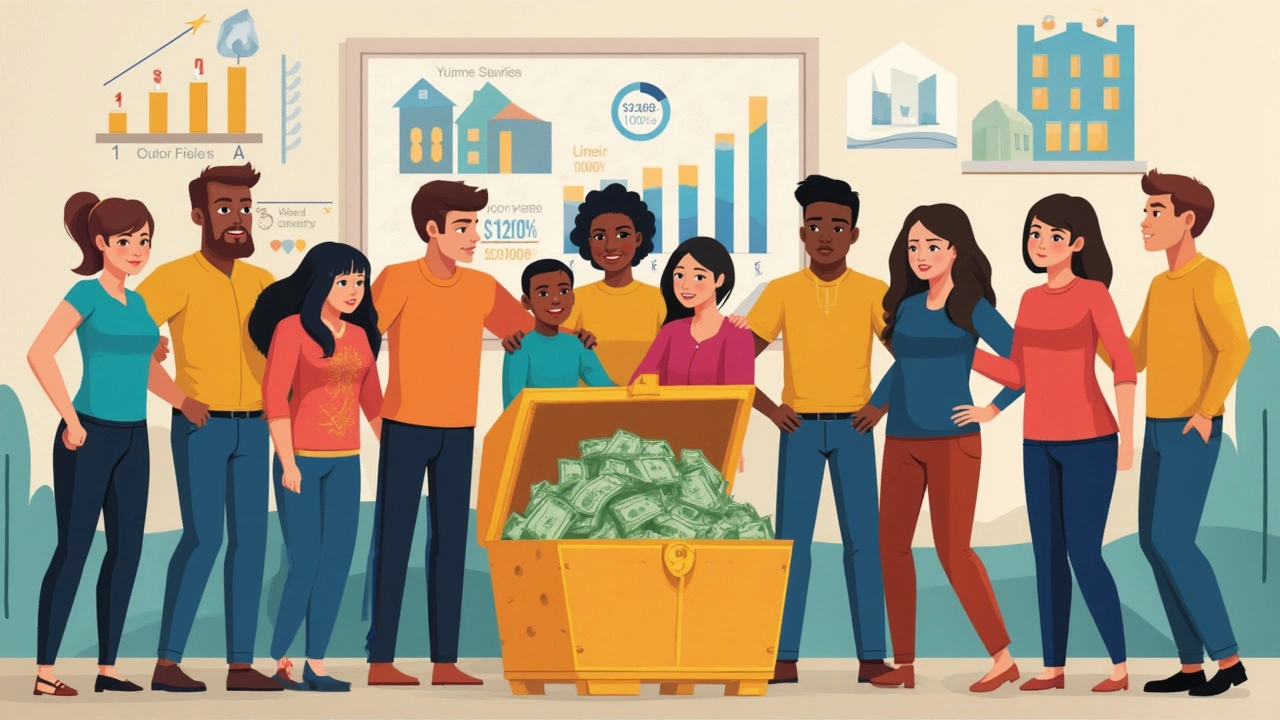How Many Americans Have $20,000 in Savings?
 Mar, 15 2025
Mar, 15 2025
Ever wonder if your savings account measures up to those of your fellow Americans? Here's a reality check: around 25% of American households have $20,000 or more in savings. It's not just a number; it's a financial cushion that many aim for yet struggle to achieve.
Why does this $20k figure matter? It's a solid emergency fund, a stepping stone to bigger investments, and a cushion that offers peace of mind. But reaching this goal might feel like a Herculean task, especially if your balance is more familiar with two digits than five. Don't fret; there's actionable science and strategy behind those who succeed.
Think of this as your playbook for reaching that financial milestone. We’ll explore how cultural norms, lifestyle choices, and even geography play into savings habits. Plus, I've got some straightforward strategies that could help bolster your finances without living on a diet of ramen noodles.
- Understanding the Savings Landscape
- The Relevance of $20,000 in Savings
- Strategies to Reach $20,000 Savings
- Boosting Your Savings: Real-Life Tips
Understanding the Savings Landscape
When we talk about Americans and their savings habits, the picture is quite varied. Some folks have hefty savings tucked away, while others barely have a financial cushion. So why such a stark difference?
Well, it turns out that Americans savings habits are influenced by a bunch of stuff, like income levels, education, and even where you live. A 2023 survey showed that around 25% of U.S. households have hit that magic number, $20,000 savings. But that leaves a good chunk of folks who haven’t. What's going on there?
Income and Lifestyle
First things first, income plays a huge role. If you're earning more, you're generally saving more—makes sense, right? But it's not all about income. Two people earning the same amount can have wildly different savings based on their lifestyle choices. Someone opting for a Netflix night over a swanky restaurant meal is more likely to have extra cash stashed away.
Geographical Differences
Then there's where you live. City slickers often face higher rent and expenses, which can eat into savings. Meanwhile, folks in smaller towns might find it easier to save because of lower living costs.
Let's look at some numbers:
| Region | Average Savings ($) |
|---|---|
| Urban | 15,000 |
| Suburban | 20,000 |
| Rural | 25,000 |
These figures show that your address can impact your bank account more than you might think.
Education and Financial Literacy
The more you know, the more you grow. Seriously, people with higher levels of education or who have taken financial literacy courses often have better saving strategies. They know about the magic of compound interest and have heard the call of investment opportunities that others might miss.
In a nutshell, understanding the landscape where financial statistics are concerned helps folks figure out where they stand and where they need to make changes.
The Relevance of $20,000 in Savings
Aiming for a savings account stacked with $20,000 isn’t just a random goal; it's a financial milestone with practical implications. Let's break it down.
Why $20,000?
First off, having $20,000 in savings serves as a crucial safety net. Imagine your car needs urgent repairs, or you're in between jobs. Instead of panicking, you have the funds to handle these hiccups without breaking a sweat. Experts suggest an emergency fund equivalent to 3-6 months of living expenses, and for many, $20,000 covers that sweet spot.
Another reason it's pivotal is because it opens doors to investment opportunities. We’re talking about investments with better returns than a simple savings account. Whether it's stocks, bonds, or even real estate—having a sizable safety net means you can afford to take those calculated risks.
The Psychological Comfort
There’s also a psychological perk to hitting this benchmark. Financial stress is no joke—it’s linked to everything from health issues to relationship troubles. Knowing you’ve got a firm cushion, like $20,000 in savings, can significantly ease those worries, giving you peace of mind.
Stats That Matter
Let's look at some stats to paint the picture:
| Percentage | Description |
|---|---|
| 25% | Percentage of American households with at least $20,000 in savings. |
| 72% | People who report feeling less stressed when they surpass this savings threshold. |
So, while it may seem like just a number, $20,000 in savings is a solid foundation that sets you up for a sturdy financial future. It's about building confidence, flexibility, and a financial buffer to tackle life's surprises.

Strategies to Reach ,000 Savings
Reaching that $20,000 savings goal might seem like a mountain, but it's totally climbable with the right plan. Let's break it down into smaller, digestible steps to help you get there without stress.
1. Set a Realistic Budget
First things first, look at where your money goes every month. Do a reality check on your expenses and see where you can cut back. Use apps like Mint or YNAB (You Need A Budget) to keep track and stay accountable.
Set some ground rules for eating out, daily coffee runs, or those impulse buys that add up. Every little saving gets you closer to that $20,000.
2. Automate Your Savings
Consider setting up an automatic transfer to your savings account as soon as your paycheck hits. It's like paying yourself first and you won’t be tempted to spend it right away. Even a small automatic deduction every month can grow over time.
3. Upskill and Boost Your Income
Investing in new skills can pay off big time. Look for online courses or certifications in fields that interest you. A side hustle like freelancing, dog walking, or even selling crafts online can also boost your savings.
4. Deal with High-Interest Debt
Piling up savings while having high-interest debts is like trying to fill a leaking bucket. Tackling those first can free up more cash for savings in the long run. Consider consolidating debts to reduce interest and simplify your payments.
5. Evaluate Your Insurance
Regularly review your insurance policies to see if you’re overpaying. Sometimes, switching providers can save you hundreds a year. It's an easy win for boosting your savings.
6. Monitor Your Progress
Keep tabs on how your savings grow over time. Seeing that number go up can motivate you to stick with it. Celebrate each small milestone on your way to $20k!
Remember, achieving $20,000 in savings isn’t about depriving yourself—it’s about making smarter choices. Persistence and a little creativity can get you to that financial sweet spot before you know it.
Boosting Your Savings: Real-Life Tips
Looking to give your savings account a little TLC? Here are some real-life tips that can help any American reach that enviable $20,000 benchmark and start living more comfortably.
Set Realistic Goals
First things first, don't set yourself up for failure by aiming too high. Start with small, achievable targets. If you’re starting out with just a few hundred dollars, aim for $1,000 first. Once you reach that goal, $5,000 won’t seem as daunting.
Automate Your Savings
One of the easiest ways to save is by automating the process. Set up a monthly transfer from your checking to your savings account. Think of it as paying yourself first.
Cut Unnecessary Expenses
Take a hard look at your spending habits. Do you really need that morning latte, or could you brew your own at home? Small changes can contribute significantly over time.
Take Advantage of Employer Benefits
If your employer offers a 401(k) match, make sure you’re not leaving free money on the table. Contribute enough to get the full match; it’s one of the simplest ways to boost your savings.
Side Hustles
If your main job isn’t cutting it, consider a side hustle. Whether it’s freelancing, driving for a ride-share, or selling crafts online, extra income can hugely benefit your savings.
Watch Your Progress
Tracking your progress can motivate you to stick with your savings plan. Use apps or spreadsheets to see how close you're getting to that $20,000 savings mark.
| Method | Potential Savings/Month |
|---|---|
| Automated Savings | $200 |
| Reducing Expenses | $150 |
| Side Hustle Earnings | $300 |
Incorporate some or all these tips, and you'll watch your savings grow. Make saving a habit, and you'll be better prepared for whatever life throws your way!
